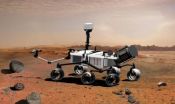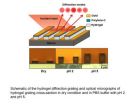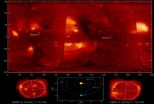(Press-News.org) RICHLAND, Wash. – Finding life on Mars could get easier with a creative adaption to a common analytical tool that can be installed directly on the robotic arm of a space rover.
In a recent paper published online in the journal Planetary and Space Science, a team of researchers propose adding a laser and an ion funnel to a widely used scientific instrument, the mass spectrometer, to analyze the surfaces of rocks and other samples directly on Mars' surface. The researchers demonstrated that the combined system could work on the spot, without the sample handling that mass spectrometry usually requires.
"There are a lot of exciting discoveries about Mars that have yet to be made," said the paper's lead author, Paul Johnson. "This technique could make understanding the composition of rocks and soils on Mars — possibly including evidence of life — much easier."
Johnson, of NASA's Jet Propulsion Laboratory in Pasadena, Calif., came up with the idea after reading about an ion funnel technology for mass spectrometry developed by Keqi Tang and Dick Smith of the Department of Energy's Pacific Northwest National Laboratory. William Brinckerhoff of NASA's Goddard Space Flight Center in Greenbelt, Md., contributed his expertise in miniaturizing scientific instruments to the project, while Robert Hodyss, also of JPL, provided hands-on expertise during experimentation and testing.
Here on Earth, mass spectrometry is a common analytical technique scientists use to identify molecules, their elements and their isotopes in samples ranging from rocks to proteins. It works by turning a sample's molecules into electrically charged ions. A mass spectrometer then precisely measures the mass of ions and ion fragments to identify the sample's contents at a detailed molecular level.
Mass spectrometry isn't new to space exploration. It was used to analyze Martian soil for the first time as part of NASA's Viking program in the 1970s. And it's planned to be part of the Mars Science Laboratory's Curiosity rover, which will lift off for the Red Planet this November. But each time it's been used in space, the samples had to be extensively prepared before they could be analyzed.
With Viking, for example, soil had to be scooped up, placed into a chamber and heated to make the sample a gas before it could be analyzed. The Mars Science Laboratory will be able to do a more thorough sample analysis than Viking could, but it will still need to prepare its samples beforehand. The more a sample has to be handled, the greater chance there is for the equipment to malfunction or the analysis to fail.
On Earth, scientists do mass spectrometry within a vacuum chamber. But that requires either finding a small enough sample, or cutting down the sample to fit into the chamber. Any such efforts on Mars have to be done with a robotic rover that's controlled by human operators millions of miles away.
"Cutting rocks, picking them up and moving them around, all this adds complexity," Johnson said. "Complexity makes it more difficult to conduct experiments with a robotic rover. Plus, adding new tools so the instrument can do these extra tasks increase size, weight and power consumption. All this makes sending a mass spectrometer into space even more challenging."
Trying to simplify this work, Johnson and Hodyss at JPL, which manages NASA's Mars Exploration Project, turned to a technique called laser ablation. The method involves shooting a laser at the sample's surface, which creates a plume of molecules and ions that can then be analyzed by the mass spectrometer.
But how do you get the sample ions to enter the mass spectrometer? Even on our planet, that problem has plagued researchers for years. A large percentage of a sample was traditionally lost at this stage — until recently, that is. PNNL researchers Dick Smith and Keqi Tang developed a new technology for mass spectrometers in the late 1990s to address that challenge.
Their electrodynamic ion funnel is a series of conductive, progressively smaller electric ring electrodes that efficiently pull in and focus more ions into the mass spectrometer than without the funnel. This makes mass spectrometers tremendously more sensitive. Fortunately, the ion funnel works best when its surrounding environment has an air pressure of about 5 torr, which also happens to be the atmospheric pressure on Mars.
"We didn't specifically design the ion funnel for space exploration, but we're excited that it and Mars are a good fit," said Tang.
JPL asked PNNL to help test whether the combination of laser ablation and an ion funnel could make in situ, or "in place," mass spectrometry possible on Mars. A standard laboratory mass spectrometer was equipped with laser and an ion funnel attachments, and the ion funnel end was placed inside a sealed chamber that matched Mars' atmospheric conditions. The researchers shot laser pulses at various samples, such as copper, stainless steel and gypsum. As they suspected, a small layer of each sample's surface atoms was transformed into ions and the ion funnel quickly pulled them into the mass spectrometer, which identified the samples.
"This system could be developed into a 'point and shoot' instrument for space analysis," Johnson said.
The results are promising, but further work is needed to develop ion funnel-equipped mass spectrometers ready for space. The next step is to make the system as small and light as possible so it could be used on a space exploration rover. The authors plan to pare it down enough to fit onto a rover's robotic arm.
INFORMATION:
Funded by NASA, the team performed their experiments at JPL, which is managed by the California Institute of Technology. The ion funnel they tested was developed and constructed at EMSL, the Department of Energy's Environmental Molecular Sciences Laboratory on PNNL's campus.
REFERENCE: Paul V. Johnson, Robert Hodyss, Keqi Tang, William B. Brinckerhoff, Richard D. Smith, The laser ablation ion funnel: Sampling for In Situ mass spectrometry on mars, Planetary and Space Science, online Jan. 11, 2011, DOI 10.1016/j.pss/2011.01.004. http://www.sciencedirect.com/science?_ob=ArticleURL&_udi=B6V6T-51XH9BT-3&_user=2741876&_coverDate=01%2F11%2F2011&_rdoc=1&_fmt=high&_orig=search&_origin=search&_sort=d&_docanchor=&view=c&_searchStrId=1633530430&_rerunOrigin=google&_acct=C000058656&_version=1&_urlVersion=0&_userid=2741876&md5=4af47a17c64a877fb5fd4c1d22e15485&searchtype=a#FCANote
Pacific Northwest National Laboratory (www.pnl.gov) is a Department of Energy Office of Science national laboratory where interdisciplinary teams advance science and technology and deliver solutions to America's most intractable problems in energy, the environment and national security. PNNL employs 4,900 staff, has an annual budget of nearly $1.1 billion, and has been managed by Ohio-based Battelle since the lab's inception in 1965. Follow PNNL on Facebook, LinkedIn and Twitter.
NASA's Jet Propulsion Laboratory (www.jpl.nasa.gov) is operated by the California Institute of Technology in Pasadena, Calif. The Jet Propulsion Laboratory is the lead U.S. center for robotic exploration of the solar system, and conducts major programs in space-based Earth sciences and astronomy. JPL spacecraft have visited all of the planets from Mercury to Neptune.
EMSL, the Environmental Molecular Sciences Laboratory, (www.emsl.pnl.gov) is a national scientific user facility sponsored by the Department of Energy's Office of Science, Biological and Environmental Research program that is located at Pacific Northwest National Laboratory. EMSL offers an open, collaborative environment for scientific discovery to researchers around the world. EMSL's technical experts and suite of custom and advanced instruments are unmatched. Its integrated computational and experimental capabilities enable researchers to realize fundamental scientific insights and create new technologies. Follow EMSL on Facebook.
Tool makes search for Martian life easier
Red Planet a good fit for laser-ion funnel mass spectrometry
2011-02-09
ELSE PRESS RELEASES FROM THIS DATE:
Hydrogels used to make precise new sensor
2011-02-09
WEST LAFAYETTE, Ind. - Researchers are developing a new type of biological and chemical sensor that has few moving parts, is low-cost and yet highly sensitive, sturdy and long-lasting.
The "diffraction-based" sensors are made of thin stripes of a gelatinous material called a hydrogel, which expands and contracts depending on the acidity of its environment.
Recent research findings have demonstrated that the sensor can be used to precisely determine pH - a measure of how acidic or basic a liquid is - revealing information about substances in liquid environments, said ...
Detecting pathogens in waterways: An improved approach
2011-02-09
This press release is available in Spanish.
U.S. Department of Agriculture (USDA) scientists have come up with a way to detect pathogenic Escherichia coli and Salmonella bacteria in waterways at lower levels than any previous method. Similar methods have been developed to detect pathogenic E. coli in meat products, but the approach by the scientists with USDA's Agricultural Research Service (ARS) represents a first for waterways.
ARS is USDA's principal intramural scientific research agency, and this research supports the USDA priority of ensuring food safety.
When ...
UT Study: Charismatic leadership can be measured, learned
2011-02-09
KNOXVILLE -- How do you measure charisma? That's the question UT professor Kenneth Levine seeks to answer.
Much has been written in business management textbooks and self-help guides about the role that personal charisma plays in leadership. But according to a newly published study co-authored by Levine, a University of Tennessee, Knoxville, communications studies professor, until recently no one was able to describe and measure charisma in a systematic way.
Levine said the large amount of academic literature on charismatic leadership never defined what it means to ...
The hitch in the drug? The itch in the drug
2011-02-09
Scratching deep beneath the surface, a team of researchers from the University of California, San Diego School of Medicine and three South Korean institutions have identified two distinct neuronal signaling pathways activated by a topical cream used to treat a variety of skin diseases. One pathway produces the therapeutic benefit; the other induces severe itching as a side effect.
The findings, published in this week's early online edition of the Proceedings of the National Academy of Sciences, point to the possibility of designing future drugs that effectively treat ...
Dramatic improvement in Parkinson disease symptoms
2011-02-09
New Rochelle, NY, February 8, 2011—Successful intranasal delivery of stem cells to the brains of rats with Parkinson disease yielded significant improvement in motor function and reversed the dopamine deficiency characteristic of the disease. These highly promising findings, reported in Rejuvenation Research, a peer-reviewed journal published by Mary Ann Liebert, Inc. highlight the potential for a noninvasive approach to cell therapy delivery in Parkinson disease–a safer and effective alternative to surgical transplantation of stem cells. The article is available free online. ...
NRL researchers view the sun in 3-D
2011-02-09
Beginning on February 6, 2011, the two STEREO spacecraft are 180 degrees apart providing Naval Research Laboratory (NRL) scientists with a 360-degree view of the Sun. NASA's STEREO (Solar Terrestrial Relations Observatory) spacecraft were launched on October 25, 2006, and have been gathering spectacular images of solar activity, especially solar storms, since the mission began.
A key component of the STEREO mission is NRL's Sun Earth Connection Coronal and Heliospheric Investigation (SECCHI), a suite of five scientific telescopes that observe the solar corona and inner ...
Scientists develop method to identify fleetingly ordered protein structures
2011-02-09
LA JOLLA, CA – February 8, 2011 - A team of scientists from The Scripps Research Institute and the University of California, San Diego (UCSD) have developed a novel technique to observe previously unknown details of how folded structures are formed from an intrinsically disordered protein. The insights could help scientists to better understand the mechanism of plaque formation in neurodegenerative disorders such as Parkinson's and Alzheimer's diseases.
The results of the study, which has broad implications for the field, were recently published in an advanced, online ...
New techniques for stapling peptides could spur development of drugs for cancer
2011-02-09
BUFFALO, N.Y. -- Researchers at the University at Buffalo have devised two new ways of "stapling" peptide helices to prevent these medically important molecules from losing their shape and degrading in the presence of enzymes.
The discovery could help speed the development of peptide-based drugs against diseases including cancer. UB scientists say the methods they pioneered are simpler than existing techniques, one of which employs an expensive ruthenium catalyst to connect chemical side chains that protrude from the main body of helical peptides.
"There's a lot of potential ...
Gene protects lung from damage due to pneumonia, sepsis, trauma, transplants
2011-02-09
Lung injury is a common cause of death among patients with pneumonia, sepsis or trauma and in those who have had lung transplants. The damage often occurs suddenly and can cause life-threatening breathing problems and rapid lung failure.
There are no effective treatments. Patients usually are put on ventilators to give their lungs a chance to heal, but there is little else doctors can do but wait and hope for the best.
Now, researchers at Washington University School of Medicine in St. Louis report they have identified a gene that limits damage to the lung during acute ...
Electronic cigarettes hold promise as aid to quitting
2011-02-09
A study led by Boston University School of Public Health (BUSPH) researchers reports that electronic cigarettes are a promising tool to help smokers quit, producing six-month abstinence rates nearly double those for traditional nicotine replacement products.
In a study published online ahead of print in the American Journal of Preventive Medicine, researchers found that 31 percent of respondents reported having quit smoking six months after first purchasing an electronic cigarette, a battery-powered device providing tobacco-less doses of nicotine in a vaporized solution. ...
LAST 30 PRESS RELEASES:
Why nail-biting, procrastination and other self-sabotaging behaviors are rooted in survival instincts
Regional variations in mechanical properties of porcine leptomeninges
Artificial empathy in therapy and healthcare: advancements in interpersonal interaction technologies
Why some brains switch gears more efficiently than others
UVA’s Jundong Li wins ICDM’S 2025 Tao Li Award for data mining, machine learning
UVA’s low-power, high-performance computer power player Mircea Stan earns National Academy of Inventors fellowship
Not playing by the rules: USU researcher explores filamentous algae dynamics in rivers
Do our body clocks influence our risk of dementia?
Anthropologists offer new evidence of bipedalism in long-debated fossil discovery
Safer receipt paper from wood
Dosage-sensitive genes suggest no whole-genome duplications in ancestral angiosperm
First ancient human herpesvirus genomes document their deep history with humans
Why Some Bacteria Survive Antibiotics and How to Stop Them - New study reveals that bacteria can survive antibiotic treatment through two fundamentally different “shutdown modes”
UCLA study links scar healing to dangerous placenta condition
CHANGE-seq-BE finds off-target changes in the genome from base editors
The Journal of Nuclear Medicine Ahead-of-Print Tip Sheet: January 2, 2026
Delayed or absent first dose of measles, mumps, and rubella vaccination
Trends in US preterm birth rates by household income and race and ethnicity
Study identifies potential biomarker linked to progression and brain inflammation in multiple sclerosis
Many mothers in Norway do not show up for postnatal check-ups
Researchers want to find out why quick clay is so unstable
Superradiant spins show teamwork at the quantum scale
Cleveland Clinic Research links tumor bacteria to immunotherapy resistance in head and neck cancer
First Editorial of 2026: Resisting AI slop
Joint ground- and space-based observations reveal Saturn-mass rogue planet
Inheritable genetic variant offers protection against blood cancer risk and progression
Pigs settled Pacific islands alongside early human voyagers
A Coral reef’s daily pulse reshapes microbes in surrounding waters
EAST Tokamak experiments exceed plasma density limit, offering new approach to fusion ignition
Groundbreaking discovery reveals Africa’s oldest cremation pyre and complex ritual practices
[Press-News.org] Tool makes search for Martian life easierRed Planet a good fit for laser-ion funnel mass spectrometry



